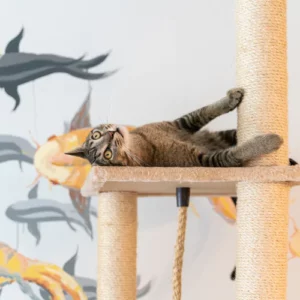Knowing the cat’s past treatment or background will help plan future socialization. Whether it suffered from mistreatment, living in the streets or some other trauma, it will help in understanding where it is at and planning to make the cat your pet, and part of your life. I believe all animals have much love to give, if shown what love is, and that it does exist.
Consider any trauma or negative experiences the cat might have endured. Trauma can manifest in many ways, from being skittish and hiding to showing aggression or appearing distant. Recognizing these behaviors as potential trauma responses rather than seeing them as bad behavior is crucial. This perspective shift fosters more patience and understanding, paving the way for a more empathetic approach.
Showing patience is your best ally. Some cats may adjust in days, while others may take weeks or even months. Being patient respects their individual journey and nurtures trust. By allowing the cat to take their time, you’re setting up a foundation of trust which is essential for effective socialization.
Create a Safe Environment
Setting up a cozy and quiet space for your rescue cat can make all the difference. Think of it like creating a personal sanctuary where they can feel safe and secure. Start with a quiet room where they won’t be disturbed much—a place away from high-traffic areas in your home.
Provide cozy nooks, soft bedding, and a few favorite toys. Hiding spots like boxes or covered cat beds allow them to retreat when they feel overwhelmed. Making sure they have places to hide can reduce anxiety and provide comfort.
Limiting their access to large areas initially helps prevent overwhelm. It’s like baby steps—letting them get used to one space at a time. They can gradually explore more of the house as they start to feel more comfortable. It’s all about giving them control over their environment in a manageable way.
Gradual Introduction to the Household
Once your rescue cat feels secure in their safe space, it’s time to let them explore other parts of your home. Introduce them to new rooms slowly. Let them wander and sniff around at their own pace.
It’s important not to overload them with new experiences all at once. Keep the environment calm and predictable. Gradually introduce them to new sounds and smells, like the hum of kitchen appliances or the scent of different rooms. Each new discovery should feel like a small adventure, not a daunting challenge.
Be mindful of their reactions. If they seem curious and relaxed, you’re on the right track. If they show signs of stress, like hiding or excessive grooming, give them some time before trying again. Your goal is to build their confidence with each new experience.
Remember, patience is your friend here. You can’t rush trust. Allowing the cat to explore at their own pace will help them feel more in control and reduce anxiety. This gradual introduction sets the stage for a smoother transition into your household.
Positive Reinforcement Techniques
Using positive reinforcement can help your rescue cat feel more at ease. Treats and gentle praise work wonders in encouraging calm and social behaviors. Catch them in a moment of curiosity or friendliness? Reward that with a tasty treat or a kind word.
These rewards should come when the cat shows positive behaviors like exploring new areas, approaching you, or interacting with toys. It helps reinforce that these actions lead to something good. This is not only encouraging but also teaches them that the environment is safe and enjoyable.
Avoid punishments at all costs. Punishments can increase fear and stress, making socialization even harder. Instead, focus on rewarding positive actions and creating positive associations.
Being consistent with these techniques helps build a stronger bond between you and your cat. Over time, they’ll start to associate your presence and interactions with positive outcomes, making them more likely to be open and sociable.
Gentle Handling and Interaction
Letting the cat come to you first is the best approach. Don’t force interaction. Sit quietly in their space, maybe read a book or watch something on your phone. Let them get used to your presence. Over time, their curiosity will get the better of them.
When the cat does approach, start with slow, gentle touches. Avoid quick or sudden movements that might startle them. Think of it as a series of small, calm gestures. These early interactions should feel relaxed and non-threatening.
Spending quiet time near them helps build trust and comfort. Your patience will show them that you’re not a threat. Even just sitting next to them without direct interaction can be a huge step forward. This way, they learn that your presence is a safe and constant part of their environment.
Using Enrichment Tools and Seeking Professional Help
Enrichment tools are a game-changer for helping your rescue cat adapt. Scratching posts, puzzle feeders, and interactive toys can stimulate their mind and keep them engaged. These tools provide both mental and physical exercise, which can reduce anxiety and encourage more social behaviors.
Rotate the toys regularly to keep things interesting. This not only prevents boredom but also keeps their curiosity piqued. Variety is key here. One day it’s a puzzle feeder; the next, it’s a dangling feather toy. Mixing it up helps maintain their interest without overwhelming them.
If you notice your cat showing severe signs of stress, fear, or aggression, getting professional help is a smart move. A veterinarian can rule out any underlying health issues that might be affecting their behavior. If health problems aren’t the issue, a behaviorist can provide targeted socialization techniques.
Incorporating daily playtime can make a significant difference. Regular interaction through play helps them build confidence and bond with you. Keep play sessions short and fun, making them something your cat looks forward to rather than dreads.
Seeking advice from a professional isn’t admitting failure; it’s taking a proactive step to ensure your cat’s well-being. Sometimes, expert advice can offer new strategies and insights that make all the difference.


Thank you for the insightful article on “Effective Ways to Socialize Rescue Cats.” It was informative and heartwarming to read about practical strategies for helping these cats adjust to new environments. Socializing rescue cats can be a delicate process, and your tips on patience, creating a safe space, and using positive reinforcement were particularly helpful. The emphasis on building trust gradually and understanding each cat’s unique needs highlights the compassion needed to care for these animals. Great work! Thanks.
Thank you for your meaningful comments.
Kind regards Tim
Ahh, I really love this article and the information about how to handle rescue cats is really key to the transition and the information you have provided has been really useful
My Mum had rescue kittens and the safe space that you have spoken about was so key to enabling her little ones to settle in nicely. It is incredible how comfort and slow progression as you have mentioned are such an important component to rehoming successfully.
One thing that you have not mentioned which was something that my mother faced was that the kittens that she rehomed did not have any history about their existence. The RSPCA had picked the kittens up from what could only be described as a squalor so did not know how they were brought up. In this instance how would you recommend rehoming especially food and innoculations?
Thank you
Somtimes it can be challenging to determine the history of rescue animals. I think it safe to say that their life can only I’m prove, and working with your Vet and slowly incorporating into your life can only be beneficial for them.
Thank you for the meaningful comments
Kind regards Tim